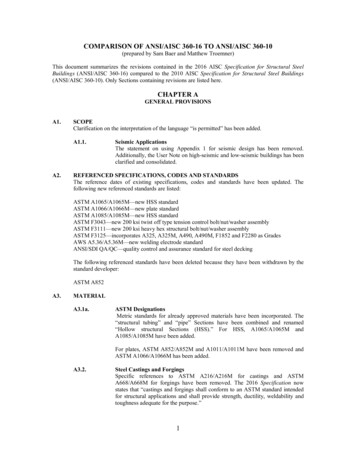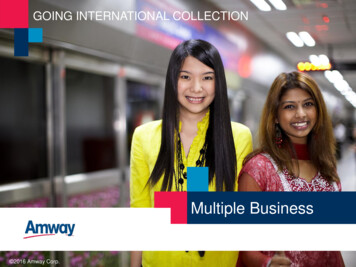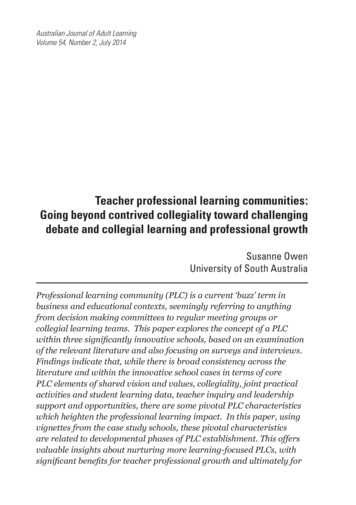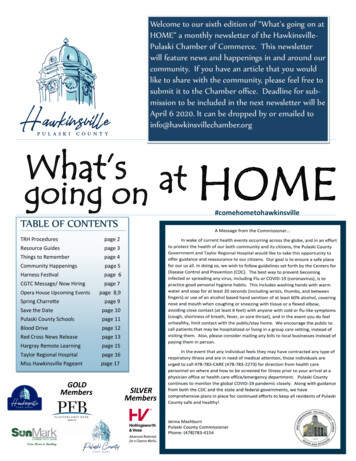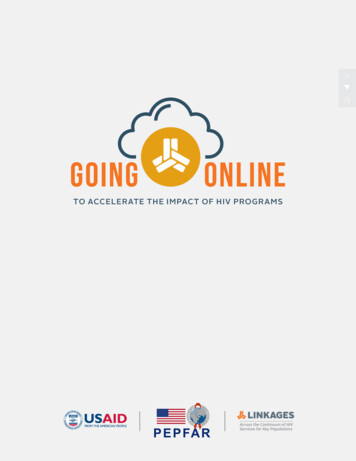
Transcription
GOINGONLINETO ACCELERATE THE IMPACT OF HIV PROGRAMSP E P FA R
LINKAGES, funded by the U.S. President’s Emergency Plan for AIDS Relief (PEPFAR) and the U.S. Agency for International Development(USAID), is the largest global project dedicated to key populations—sex workers, men who have sex with men, people who injectdrugs, and transgender people. The project is led by FHI 360 in partnership with IntraHealth International, Pact, and the University ofNorth Carolina at Chapel Hill.R ECOM M END ED CITATION:FHI 360, LINKAGES Project. 2019. A Vision for Going Online to Accelerate the Impact of HIV Programs.Washington, D.C., U.S.: FHI 360.This document was made possible by the generous support of the American people through USAID and PEPFAR through the terms ofcooperative agreement #AID-OAA-A-14-00045. The contents are the responsibility of the LINKAGES project and do not necessarilyreflect the views of USAID, PEPFAR, or the United States Government.GO I NG O NL I NE TO ACC E L E RAT E T H E I MPACT O F HI V P ROG RAM S ii
WHAT’S INSIDE1. WELCOME 42. OUR VISION 5Broader Inclusion 5Client-Centered Differentiated Services 6Improved Efficiency 6Safe and Confidential Access 7Checklist for Planning Safe andConfidential Access to Online HIV Services 93. FRAMEWORK 10Part 1. Learn and Plan 11Part 2. Reach and Link 20Part 3. Engage and Support 28Part 4. Assess and Improve 304. MOVING FORWARD 355. MORE 37GO I NG O NL I NE TO ACC E L E RAT E T H E I MPACT O F H I V P ROG RAM S iii
1WELCOMEGoing Online is a vision and evolving framework for how HIV programs can use onlineand mobile platforms to accelerate impact toward meeting their HIV education,prevention, testing, and treatment objectives. The USAID- and PEPFAR-fundedLINKAGES project developed this vision to help populations facing the greatest HIVrisks to make connections to life-affirming and life‑saving services in an increasinglyconnected world. Our vision will also be helpful to other stakeholders in the HIVresponse, including governments and community organizations seeking to modernizeand diversify approaches to reach and engage people in HIV services in ways thatmeet their needs and preferences.The document is segmented into two parts. First, we explain four principles guidingour vision for online HIV programs. Second, we offer a four-part framework explaininghow HIV programs can consider using this approach—which sets the context fordetailed guidance the project will release soon.Our vision largely speaks to the digital generation who are young, urban, and keenconsumers of social media. For the HIV programs serving people who search onGoogle for their sex education and use Instagram and WhatsApp for socializing anddating, this vision is for you. We hope that this vision will speak to the preferencesand lifestyles of those aspiring to have a better future, despite facing sexual healthrisks today.This vision helps us at LINKAGES appreciate the diversity of people we need toengage in HIV services to reach the ambitious global goal to end AIDS by 2030and the ever-expanding potential for online platforms to accelerate these efforts.We hope you also find value in this vision and help shape it through continuedadaptation and implementation.1 W E LCO MEGO I NG O NL I NE TO ACC E L E RAT E T H E I MPACT O F H I V P ROG RAM S 4
2OUR VISIONIt is becoming increasingly clear thatonline solutions are well positioned toaddress four principles that are criticalto epidemic control.Broader InclusionHarnessing online platforms to expandaccess to previously unreachedindividuals facing high risks, and moreconveniently reaching existing programbeneficiaries who already use online andmobile platforms.For a long time, HIV programs focused onengaging people through physical networks or in“hot spots” using face-to-face communication.Individuals who experienced risks for HIV butsteered clear of these hot spots in the interestsof privacy or security were considered “hard toreach” or “hidden.” This is not the case today,with internet and mobile penetration reachingover 50% in most global regions1 and many peoplefinding their sense of community and social2 O U R VI SI O Nnetworks online.2 We believe we can broadeninclusion in HIV services by opening new channelsto reach and support them through online andmobile platforms. When our online survey resultsacross several countries found a large proportionof respondents who were at risk for HIV wereneither reached by HIV programs nor received HIVservices recently, we created a new model for HIVoutreach called “generations of HIV outreach.”This model presents the history of HIV outreachapproaches and how programs have successivelyused more sophisticated technologies in outreach,and in turn, broadened their reach to newpopulations with HIV education and awareness,prevention, testing, and links to treatment. Readon to learn about LINKAGES’ online outreachmethods and how they can be implemented withinan HIV program.GO I NG O NL I NE TO ACC E L E RAT E T H E I MPACT O F H I V P ROG RAM S 5
Client-CenteredDifferentiated ServicesProviding focused, prioritized, personcentered support and a range of optionsfor engaging in HIV services that bettermeet individual preferences and needsincluding discreet virtual services andself‑guided options.Providing more options and entry points throughwhich people can engage in HIV services willmake HIV programs more accessible, relevant,and useful. However, to offer truly differentiatedoptions that satisfy the preferences of a broaderrange of people, HIV programs need to createseveral pathways for clients to engage in HIVservices that begin with outreach and extendthrough education, counseling, referral, anduptake of biomedical HIV services.3 To achievethis, we start by better understanding thepopulations we want to engage and their uniquecharacteristics. We adapted a model usedby the International AIDS Society (IAS)4, 5 toshow three elements that can help us developclient‑centered online HIV programs: health statuscharacteristics, population/demographics, andoutreach context—which can be the client’s virtualor physical setting and their relative needs forsupport. See our “population segmentation foronline HIV outreach” model described in the nextsection. Read on to learn how we understand andsegment online audiences and examples of howwe differentiated our services to better meettheir needs.Improved EfficiencyLeveraging efficiencies of virtualcommunication, automated systems, andrich user data to bring the right informationand services to the right people.ability to engage previously unreached people athigh risk, programs are beginning to documentefficiency gains through virtual engagement.6–8Bringing these innovations to scale will involvemobilizing additional resources to support newtypes of activities like engaging content creators,There is a commonly held—but scantlydevelopers, and new voices from the populationevidenced—perception that online and mobilesegments that can be reached online. It will alsosolutions must be expensive because they relyentail supporting the adoption of innovationson technology. Historically, when programsthrough documentation and knowledge-sharing,have tried to introduce virtual and onlineadvocacy with donor agencies and governmentapproaches, resource constraints have oftenstakeholders, and community engagement andrequired them to do so on a shoestring budget,leadership. Read on for practical examples of howand on the margins of existing programming.LINKAGES programs are beginning to monitorAs a result, the scale of implementation hastheir online outreach efforts, show improvedtypically been limited. Nevertheless, due to theefficiency, and share these results for scale-uprelatively low costs of engaging people onlineand sustainability.versus face‑to-face interaction, as well as the2 O U R VI SI O NGO I NG O NL I NE TO ACC E L E RAT E T H E I MPACT O F H I V P ROG RAM S 6
Safe andConfidential AccessBuilding trust and protecting service usersand providers through a secure onlineenvironment for confidential access to HIVinformation and services.Many believe online platforms are more anonymousthan face-to-face communication. For instance,those connecting through social media ormessaging apps can create a new virtual identityand may distance themselves from unwantedin‑person confrontation or violence. Indeed, onlineHIV outreach may be better suited for people whoare more willing to connect online or from theprivacy of their phone or computer. However, onlineand mobile platforms have become increasinglysophisticated in data collection and use, and ourassumptions about their anonymity may not bewarranted. Program staff and beneficiaries maybe less aware of how online platforms can monitorand use data and how other users might do harmto them.9 Additionally, the scale and centralizationof data collection from online outreach may lead todata security vulnerabilities that have the potentialfor more disastrous fallout, if there is a breach or ifclient data are handled improperly.HIV programs should “proceed with extremecaution”10 when considering the use of online andmobile platforms for outreach and service delivery.Recent examples of online advertising malpractice11and data breaches by a wide range of apps anddatabases12, 13 reveal worrisome vulnerabilities2 O U R VI SI O Nfor going online. HIV programs should seek tounderstand, minimize, or avoid these vulnerabilities,which may affect some populations more thanothers. Key populations most affected by HIVare commonly criminalized and experience socialstigma that may increase the risks they face whenconnecting with HIV services online. In somesettings, key populations are pursued by the lawthrough state and nonstate actors who activelyseek to identify key populations online and use theironline engagement against them.14, 15Carefully consider with affected communitieswhether the risk of online outreach outweighs thepossible benefits. Programs will need to considercommunity-specific risks by engaging communitymembers and tailoring this vision and framework tothe country and audience context. Another methodto circumvent some vulnerabilities is to design anonline outreach brand and service delivery strategythat are broad and do not require people to disclosetheir status as a member of a criminalized orvulnerable population (see more in developing anonline brand and content).The safety and privacy of beneficiaries and staff,and their trust in the program, are criticallyimportant for all HIV programs. As such, onlineand mobile platforms require new safeguards andheightened awareness. As a starting point, you canuse our checklist to help you consider importantfactors for planning safe and confidential access foronline HIV services.GO I NG O NL I NE TO ACC E L E RAT E T H E I MPACT O F H I V P ROG RAM S 7
CHALLENGES WHEN GOING ONLINEDespite this optimistic vision for going online, Balancing the program’s pressure to reachsome challenges will persist, and new ones willmore people online, while respecting the onlineemerge, thereby setting a learning agenda for usspaces and communities who may not have HIVas we move through implementation. Examples ofas a primary topic of interest (such as avoidingthese challenges includeintrusive online outreach and maintaining Broader reach but lower conversion ofclients to uptake services because of usingmore impersonal modalities to connect andcommunicate with clients A steep learning curve involved in the moresophisticated use of technologies and onlineplatforms in program implementation New safeguards for communities andbeneficiaries as a result of increased publicexposure of the HIV program and newmodalities for communication, data collection,respect for safe online community spaces) The need to (1) ensure equity and inclusionamong beneficiaries reached though onlineapproaches and (2) continue diversifying bothonline and offline outreach so that the mostvulnerable are not left out Upward (donor-oriented) and externaladvocacy and knowledge-sharing ofapproaches and results to formalizeapproaches in the design and monitoring offuture HIV programsand use2 O U R VI SI O NGO I NG O NL I NE TO ACC E L E RAT E T H E I MPACT O F H I V P ROG RAM S 8
C H ECKL IST FO R PL A N N ING SAFE AND CONFIDENTIALACC ESS TO O N L I N E H IV SERVIC ESThis checklist can be used as a starting point forenhancing the safety and confidentiality of online HIVservices. Considerations at each stage of LINKAGES fourpart framework for Going Online comprise this checklist.Additional considerations important to the community,target audiences, and HIV program should be includedand the entire list should be reviewed together to cometo consensus on whether each consideration has been12LEARN& PLANduly addressed. Many contextual factors will impactthe salience of each consideration and will impact howprograms plan to address them in their programming. Thechecklist focuses on protecting clients engaging with theonline HIV program; however, some considerations arerelevant for individuals, such as online outreach workers,providing such services. Click on the magnifying glass iconto learn more about each consideration.1 Online HIV outreach has clear benefits for the target audience’s health service access and outweighs risks2 Stakeholders and experts are engaged to guide safe online outreach3 Local legal context reviewed and used to inform online HIV program4 Data collected to guide the program is secured and not individually identifying5Branding and content for the online HIV program is broad enough for the target audience to comfortablyaccess services and protect providers6 Staff are prepared to provide safe and confidential services to clients through online and mobile platforms7 Secure communication channels with clients8 Clients provide informed consent before their data are collected9 Online service directories protect the privacy and discretion of physical sites, where necessaryREACH& LINK34ENGAGE&SUPPORTASSESS&IMPROVE2 O U R VI SI O N10Staff at clinical referral facilities are trained to provide inclusive and competent care to target audiences,including key populations11Communicate the importance and processes for ensuring safety and privacy through the program’sonline presence12 Clients can communicate with a real person for support13 The program ensures that clients are followed-up discreetly to avoid inadvertent disclosure14 Clients refer their friends and partners to uptake services without sacrificing eithers’ confidentiality15 Databases with client information are secured16 Limit collection of identifying information and use unique identifying codes17 Clients can report issues and provide feedback on outreach, referral, and clinical services18 Clients view/edit their personal data collected by the program19 Data sharing and presentation are securedGO I NG O NL I NE TO ACC E L E RAT E T H E I MPACT O F H I V P ROG RAM S 9
3FRAMEWORKThe online space can be a bewildering environment. HIV programs need a strategic framework to guide implementationof online outreach to meet their objectives across the HIV services cascade, including HIV prevention, care, andtreatment. At LINKAGES, we use a simple four-part framework (Figure 1) that follows a program planning cycle to plan,implement, support, and improve online HIV services. Within the scope of HIV services, this framework has primarilysupported HIV testing objectives and links to treatment for people diagnosed HIV positive. Each stage is brieflydescribed below, and the following sections will explain each of their associated approaches and examples of how theyhave been used in various contexts. Another version of this figure, at the end of this document, shows more granulardetail of the client flow and data collection and use processes.FI GU RE 1. A framework for Going OnlineCLICK TO NAVIGATELEARN& PLANLearn about online populations at risk for HIV,engage them in the program, and align onlineoutreach strategies and HIV service options tomeet their preferences and needs.R EACH& LI N KMapping andprioritizationSocial listening andengagementOnline Outreach ApproachesDevelopOnline Brandand ContentSocial networkSocial influencerHIV SERVICES:Adaptively engage clients over time in support oftheir HIV prevention, care, and treatment needs.ASS ESS &I M P ROV EData from outreach efforts, uptake of services,and client/patient feedback are monitored andused in real time for program improvement.3 F RA MEWO RKOnline tooffline linksSocial profileCreate an online presence for the HIV programusing online outreach approaches and referclients for HIV services.E N GAG E &SU P PO RTProgramplanningExpanded and differentiated service optionsincluding public, private, and r and owdsourcingGO I NG O NL I NE TO ACC E L E RAT E T H E I MPACT O F H I V P ROG RAM S 10
PART 1.L E A R N AN D PL A NWell-targeted HIV programs begin bygetting to know their target audience.This first phase provides inputs forplanning online outreach, including howand where to reach people with relevantservices through online platforms.Digital Development PrinciplesAt their start, HIV programs should consider how theirproposed online solutions will build on local capacities,fit local contexts, and be expanded and sustained in thelong run. See the Principles for Digital Developmentwebsite for more considerations for digital solutions.The first part of the framework is called “learnand plan” and refers to better understandingand engaging the populations at risk for HIV thattechnology use, risk behaviors, and preferencescan be reached online. Learning and planningand (b) “mapping approaches,” used to learn whereincludes using online surveys, hosting focus groups,audiences can be reached via online and mobileengaging communities, and collecting other formsplatforms. HIV programs use learning and planningof data. These can be categorized into two kindsdata to design and refine their online outreachof activities: (a) “social listening” approaches thatapproaches, referral mechanisms, and service optionshelp the program learn more about their audiences’to meet their audience’s needs and preferences.A LINKAGES CONCEPTUnderstanding Diverse PopulationsLINKAGES uses the figure on the next page (Figure 2) to guide us as we learn about populationsat risk for HIV. This entails understanding our target audiences’ demographics and other populationdetails, their client characteristics (related to health status), and the outreach context that makes themost sense for them. Each of these dimensions are described below with examples of the relevance forthe design of programs.SubpopulationsSubpopulations are distinguished by gender, age, risk level, and socioeconomic context. An individual’ssocioeconomic level, for
going online to accelerate the impact of hiv programs ii LINKAGES, funded by the U.S. President’s Emergency Plan for AIDS Relief (PEPFAR) and the U.S. Agency for International Development (USAID), is the largest global project dedicated to key populations—
